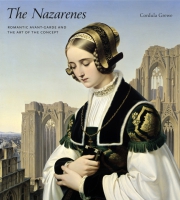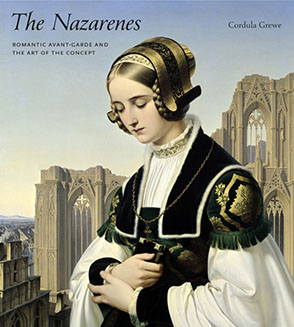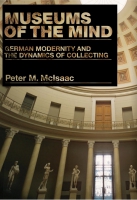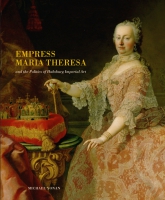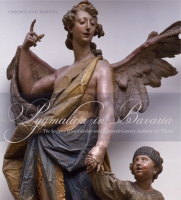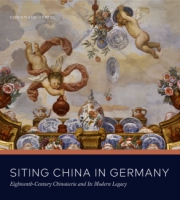The Nazarenes
Romantic Avant-Garde and the Art of the Concept
Cordula Grewe
“This beautifully produced and written book provides an overarching history of a misunderstood and easily pigeonholed group of artists. But Cordula Grewe goes on to mount an impressive project of historical understanding that makes the Nazarene artist group accessible by returning them to the history of art, from which they have been largely absent. Grewe challenges the reigning conception of modernity to make room for something modernist critics have been happy to use as a foil. In the end, she argues that the artists who preferred thought to materiality turn out to have been precursors of very modern conceptual art.”
- Description
- Reviews
- Bio
- Table of Contents
- Sample Chapters
- Subjects
“This beautifully produced and written book provides an overarching history of a misunderstood and easily pigeonholed group of artists. But Cordula Grewe goes on to mount an impressive project of historical understanding that makes the Nazarene artist group accessible by returning them to the history of art, from which they have been largely absent. Grewe challenges the reigning conception of modernity to make room for something modernist critics have been happy to use as a foil. In the end, she argues that the artists who preferred thought to materiality turn out to have been precursors of very modern conceptual art.”
“Revisions of modernism seem perpetually in the works these days. But there is perhaps none more persuasive and stimulating than Cordula Grewe’s The Nazarenes. An exciting new history of this nineteenth-century Germanic movement—and a rare one in English—the book’s narrative offers a fresh critical take on the Nazarenes’ retrospective vanguard art. Along the way, Grewe convincingly places the Nazarenes at the beginning of a genealogy of conceptualism in art, arguing for the lasting effects of their self-reflective picture theory.”
“In this engaging and thought-provoking study, Cordula Grewe challenges the commonly held view that the Nazarenes were conservative and outmoded in comparison to the innovations of the avant-garde. Grewe complicates this simplistic binary narrative by proposing an important reappraisal of their conceptual art practice as antimodernist and vanguard, communal and individual, traditional and innovative. This book puts forward a nuanced reading of the Nazarenes in their artistic, political, and cultural contexts. In doing so, Grewe offers an important rethinking of modernist art practices and their critical reception from the nineteenth century to today.”
“Cordula Grewe's bold and provocative book reconstructs the fascinating intellectual world of the Nazarenes, whose art was eminently successful and influential in the nineteenth century but is today largely neglected. Her impressive study of this philosophically ambitious movement reveals that in modern art a yearning for aesthetic simplicity and naïveté is always the result of complex constellations of ideas. In an innovative combination of meticulous readings of images with a reconstruction of the genealogies of modern art, Grewe proves that the history of the European avant-garde begins with the Nazarenes’ ideational ‘art of the concept.’ Deconstructing the conventional view of the Nazarenes, she deepens our understanding not only of the art history of the nineteenth century, but also of the modern and the postmodern. This is a book that opens the reader's eyes to the invisible in the visible.”
“This magisterial text, by the foremost international authority on its subject, is without doubt the most probing and richly nuanced account of the role of the Nazarenes in the history of art in any language. Grewe draws the Nazarene project, its generational shifts and conflicts, into the sharp and detailed focus that was a hallmark of the group’s earliest productions. The text’s special emphasis on the theoretical, even philosophical, aspirations and implications of the group’s work is balanced by attentive, often inspirational, readings of individual images. It is a happy testimony to the obsolescence of reductive modernist histories of the nineteenth century that few, if any, readers will want to contest Grewe’s assertion of the essential modernity of the Nazarenes, nor their status as perhaps the first of the historical avant-gardes.”
“The product of searching analysis as well as passionate advocacy, this study is a revelation. Cordula Grewe encompasses the whole field of Nazarene activity, from vast fresco paintings to intimate portraiture and sublime landscape lithography. There can no longer be any justification for neglecting this prescient ‘art of the concept.’”
“After two centuries of negative critical reception of this artistic movement, [this book] presents a compelling revisionist account that succeeds in recapturing the radicalism of what Johann Wolfgang von Goethe disdainfully described in 1817 as ‘neo-German, religious-patriotic art’.”
“The most penetrating treatment of this important movement in any language. Profusely illustrated, beautifully produced, and a pleasure to read, The Nazarenes is at once a global analysis of these artists’ creations and aims, and a wide-ranging polemic about the field of art history today.”
Cordula Grewe is Associate Professor of Art History at Indiana University Bloomington.
Contents
List of Illustrations
Acknowledgments
A Note on the Text
Introduction
Part 1 The Nazarene Resurrection
1 Secession
2 Collectivism
3 Avant-garde
Part 2 The Nazarene Creed
4 Reflection
5 Art
6 Historical Symbolism
7 Hieroglyph
8 Nature
9 Appropriation
10 Objectified Subjectivity
11 Emulation and Epigonality
12 Coda: Anamnestic Totalization
Part 3 The Nazarene Divide
13 Toward a Naturalist Idealism
14 The Word Made Flesh
15 Portraiture as History
Conclusion
Notes
Bibliography
Index
Introduction
Priests worse than Calibans. A ritual to revive a corpse. A horde of pale, gloomy men with long hair and dark cloaks, living cadavers roaming the streets of Rome to unearth the presence of their God in the symbols of the elders, moving across the Alps and into the world driven by an unslakeable thirst to remake all art in their image. This language of the undead—the Calibans evoked by Johann Wolfgang Goethe in 1805, and Friedrich Theodor Vischer’s reanimated corpse of 1841—seems almost absurd when we look at the source of this angst, the art of the Nazarenes. Such sweet Madonnas and loving Christs, bloodless martyrs and sugary saints, which seem to pose little threat except, perhaps, to the hypersensitive nerves of the discerning modernist (see fig. 1). Goethe dared to differ. To him, the young rebels of 1809, those brethren of the Brotherhood of Saint Luke, who would father the Nazarene movement, seemed more dangerous than Prospero’s monstrous slave. Their medievalism, he sensed, was a form of cannibalism that was about to devour the glorious bodies of a rational, earthly antiquity. After all, “Caliban” probably originated as an anagram for “cannibal.” Vischer shared Goethe’s aesthetic creed and suspicion of traditional Christianity, although, as a Left Hegelian critic, he objected for different political reasons to this particular revival of models past. And, writing almost forty years after Goethe, Vischer no longer strove preemptively against a budding movement. By midcentury, Goethe’s worst fears had been realized. The Nazarenes were a major, if persistently controversial, force in German culture, a force with royal sanction, institutional backing, and international influence.
The language of the undead underlies another accusation frequently launched at the Nazarenes: that their art is not viable because of its purely conceptual character. Nazarene art is but mental images, their detractors charge, thought-images born from the mind alone, excessively intellectual and exasperatingly discursive, figments of the imagination breaking through the artist’s skull, virginal and combative as Athena but with none of her fleshly solidity, an endless series of logogryphs whose pleasure lies in the decipherment of riddles with no promise of sensual gratification. In short, Nazarene art is ideational art, or Gedankenkunst. If the image of the revived corpse conjures up decay and violated flesh, a plague of the risen dead out to infect what is vital and healthy, the epithet Gedankenkunst denoted to the Nazarenes’ adversaries a stillborn perversion of the Platonic tradition, a homunculus that can survive only in vitro, the despicable Other to a picture of life in its full existence and fullest enjoyment of being. Painting is killed off, as the work inscribes ideas instead of giving birth to materially satisfying forms.
Undead for some, Nazarene imagery was a source of renewed spiritual life for many. And faith was not the only thing they resurrected. Some, including George Eliot, marveled at the artists’ power to resurrect past mysteries and to restore speech to those glorious pictures of bygone eras that had languished in mute beauty, silenced by the ignorance of even their most admiring critics. It mattered to Eliot that the flower-flushed tomb in Raphael’s Coronation of the Virgin was not merely an ornamental vase of the painter’s fancy, as William Hazlitt had suggested, and she credited the Nazarene brush with the feast of having Raphael’s lilies bloom again in full symbolic eloquence. It was its own kind of magic, and even Eliot’s rather skeptical partner, George Henry Lewes, agreed that these German Romantics had lent “real genius to the attempt to revive the dead forms of early Christian art.”
Genius or not, John Ruskin still caught a whiff of the grave about the Nazarene undertaking, and he felt compelled to warn his contemporaries of its dangers. Petrification, memories of mankind’s fall from grace, and a quite visceral fear of suffocation mingle in his dismissal of “Teutonic art” as a “mere earth Ammonite, or headless serpent (ending in German Philosophy Constrictor powers—with no eyes).” The market thought otherwise, and Ruskin must have been dismayed when he learned from his father that the important London publisher John Murray had rejected the first volume of his Modern Painters because the audience was clamoring for works on the German school. How could public and publisher turn their back on Turner’s lush landscapes and dazzling skies, Ruskin fumed, to sink into the mud created by these unhappy Germans, so “strained, artificial, and diseased”?
At the beginning of the twenty-first century, Ruskin would not have suffered such rejection. The Nazarenes’ critical fortunes fared less well in the twentieth century, to the extent that, in 1967, a bewildered Quentin Bell felt compelled to ask, “Who were these painters and why did they attract so much attention at a time when Ingres and Delacroix, Géricault, Corot, and Daumier were so little regarded by Englishmen?” This book gives an answer, at least partially, by recovering the theoretical dimension of this “art of the concept,” and, in doing so, its relevance for current debates. However, the discrepancy between their former visibility and today’s obscurity is still noteworthy, and despite a recent surge of exhibitions, research, and art-market interest, Bell’s perplexity prevails. Before we retrace the philosophical turn that this art took, we just might ponder for a moment a version of Bell’s question: Who were these artists? What is their art about, and why does it preserve, even today, such an uncanny power to provoke?
<1>From Rebels to Princes
Although the Nazarene story is one of success, it started modestly, to say the least, and with little promise. In 1806, at the Vienna Academy, Johann Friedrich Overbeck, a seventeen-year-old native of Lübeck, and Franz Pforr, an eighteen-year-old orphan from Frankfurt am Main, met as freshly enrolled students. Idealistic and ambitious, the novices quickly felt alienated by the daily grind of their academic education, which they believed deadened the soul and artistic imagination. Before they had even finished their rudimentary training, the two began to search for sources of renewal, and soon gathered a following of like-minded students. The first upshot of their quest was a “primitivist” turn, away from the academy’s late baroque style, admiration of the antique, and insistence on technical virtuosity. Their new heroes were medieval (or at least what the Nazarenes defined as such): above all, Raphael and Albrecht Dürer, a pair that soon became synonymous with the desire to marry Italia and Germania, the harmonious shapes of ideal beauty with the harsh outlines of realistic observation. Artistic renewal sprang up from the belief that the past held the key to the future and, as we will see, to the future of art. In this the Nazarenes were true children of their age, and their art embodied one of the epoch’s core principles: historicism. In 1808 the group agreed to meet three times every fortnight, and on a warm summer evening in July 1809, they formalized their union by handshake and oath. Dedicating their fraternity to the patron saint of painters, they named it “Lukasbund,” the Brotherhood of Saint Luke, and themselves “Lukasbrüder,” the brethren of Saint Luke.
The association, especially in being sworn by oath, made them outsiders and soon secessionists. Their youthful rebellion was nonetheless symptomatic of the spirit of the time, and representative in its reaction to the profound sense of crisis that colored the view of the new century. As Europe entered the age of revolutions, a maelstrom of social, political, and economic changes was unleashed. The established social order came crashing down, and with it customary ways of production and time-honored patterns of art patronage. The resulting sense of doom and upheaval fed into a spiritual crisis, and the Lukasbund’s turn to traditional Christianity was but one tenet within a broad struggle for a new system of belief and a binding worldview. Its drive to reform art through life—and life through art—was born from this very crisis, and the scale of the fraternity’s ambitions matched its magnitude. Resurrection, artistic and otherwise, was the highest goal of the Lukasbund’s program and its ultimate promise. Reform thus presented itself as an all-encompassing project, which posited advance in the artistic field as a vanguard action against the evils of secularization at large. Proudly, the young artists saw themselves as a phalanx that would lead the way to an overarching regeneration of all aspects of life, of the everyday as much as society and even the entire nation.
Indeed, the immediate catalyst of the Nazarene story was the upheaval brought on by the ambitions of Napoleon, whose troops occupied Vienna on May 13, 1809, for the second time during the Napoleonic Wars, and stayed until October. “What a destructive, disorderly life I see and hear around me,” Beethoven commented on the city’s dismal condition that July. “Nothing but drums, cannons, and human misery in every form.” Pforr suffered a nervous breakdown, and soon Napoleon’s presence ruptured the students’ lives for good. The academy closed, and when it reopened the following winter it admitted, due to limited resources, only Austrian citizens. Thus excluded, the Lukasbrüder seized the opportunity. On May 15, 1810, almost exactly a year after the French had entered the Austrian capital, they left for Rome. The first secession in modern art history was on its way.
After quartering initially in the Villa Malta, the Lukasbrüder found lodgings in the abandoned cells of a Franciscan monastery, San Isidoro, secularized during the Napoleonic conquest of Italy and now occupied by only a few remaining monks. Their new lodgings suited the union’s self-image as a pious society. This, however, did not mean social isolation. To the contrary, they were eager for reinforcement, and the relocation to Rome not only strengthened the union’s secessionist underpinnings but also created a forum for rapid growth. In 1812 Peter Cornelius joined, followed by Wilhelm Schadow in 1813, Philipp Veit in 1816, and Julius Schnorr von Carolsfeld, together with the brothers Ferdinand and Friedrich Olivier, in 1817. By that year the central cast of my book had assembled, and an international breakthrough was in the making.
In that same year, they finished their first collaborative project, a cycle of the Old Testament figure Joseph (see, for example, fig. 75). Executed for the quarters of the Prussian consul-general in Rome, Jakob Ludwig Salomon Bartholdy, named after him the Casa Bartholdy, the frescoes were soon celebrated as marking the rebirth of monumental mural decoration and catapulted the obscure fraternity onto the international stage. For decades they would remain an obligatory stop for any artist visiting the city. Within another three years most of the Lukasbrüder had returned back to their German homelands, where they would rise over the next decade to the heights of academic power. In 1819 Cornelius was appointed director of the Düsseldorf Academy, a position he held until 1824, when he left to lead the rival institution in Munich. In 1826 Schadow assumed Cornelius’s place at Düsseldorf. In 1830 another major position in the German cultural landscape went to a Nazarene when Philipp Veit assumed the directorship of the newly founded Städel’sche Kunstsammlung in Frankfurt am Main, a position that gave him oversight not only of the rich collection but also of the attached art school. The list went on, and the effect was momentous. In the studios and cafés in Rome, the Lukasbrüder had already drawn the attention of an international community of expatriates; now the institutional power of their academic positions enabled them to extend their reach dramatically. Assisted by an exploding print culture, which carried their designs to the most far-flung corners of the world, the Lukasbrüder succeeded in forging an international style. The Romantic rebels were turning into princes of painters.
Mailing List
Subscribe to our mailing list and be notified about new titles, journals and catalogs.
